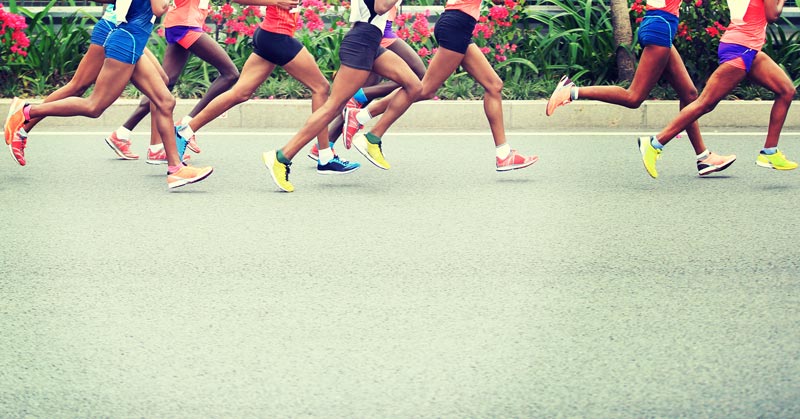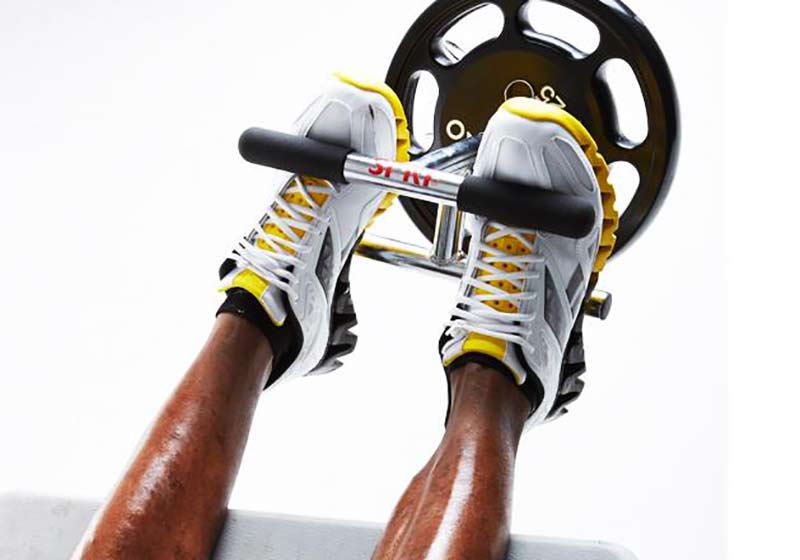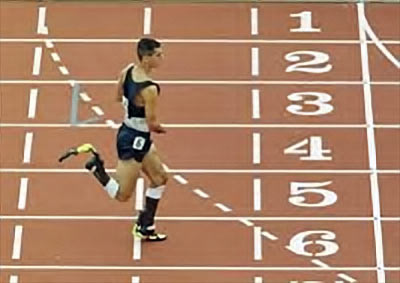[mashshare]

One Coach’s Glimpse into the Insights of Dr. Andy Franklyn-Miller
When we were all just babes in the coaching world, we probably uttered the same two words we often heard our prominent elders using to describe lower leg pain in runners: shin splints. Even if we didn’t know exactly how to explain a shin splint, we knew what it caused—the kind of pain in the front of the lower leg that, when you pressed on the specific hot point, sent runners to the roof tops. For most of us, whatever we chose to call that kind of pain, we still weren’t coming any closer to resolving it.
The riddle: When is a shin splint not a shin splint?
The answer: When it’s a stress fracture.
And a good response to this riddle might be: If the end result is basically the same—a runner out for a length of time while the healing takes place—what’s the difference, anyway?
My Son’s Experience with Shin Pain Therapies
My son was hampered throughout his prep sports career by nagging shin pain. Of course, I tried everything that sports medicine specialists and trainers were advocating. One diagnosis was that tight calf muscles were preventing him from dorsiflexing his feet. The suggested remedy was calf stretching, but it didn’t work.
Another theory was high stress of the soleus muscle at its attachment point. The problem may have been inflexible football cleats. The advice? Try different cleats. It didn’t work.
The next theory was too much shock on the lower leg bones as a result of landing a thousand times per mile with forces up to three and a half times his body weight. Additionally, he appeared to have excessive pronation. The remedy was custom orthotics, at $600 a pair. We had to buy two pairs because he outgrew the first pair. They didn’t work.
The next approach was to strengthen the lower leg muscles. To do this, we used things like the D.A.R.D. (Dynamic Axial Resistance Device), and thera-bands in every color of the spectrum. Neither of these resistance protocols helped.

Still other PTs suggested that the way to attack the problem was through stretching, acupuncture (which many now refer to as dry needling), TENS, and aggressive immobilization. Most of these treatments made little sense to me.
The last theory was the most controversial, even at that time: anterior compartment syndrome—super snug fascia resisting blood flow during running. This was our last resort. Depending on the results of the pressure test, the possible remedy was a fasciotomy. I never really considered this an option, but he did have the pressure test, and it showed only marginally elevated pressure in one of the four compartments tested.
The only therapy that did work was weekly visits to a massage therapist who had once treated Bulls guard Scottie Pippen’s nagging back problems. Those massages got him from one football game to the next and one track meet to the next. They were expensive sessions, but cheaper than a trip to the psychiatrist, which both dad and son had been contemplating.
The Problem Might Not Originate in the Foot
My only original thought after the failure of all conventional approaches was that the problem might not be necessarily related to something within the foot itself. Why was I so certain of this? Back in 1997, when he came to my high school track to run exhibition in both the 100 and 200 meter dashes, World Paralympic sprint champion Tony Volpentest mentioned that he occasionally experienced shin splints. This was really interesting because Tony was born without feet.

There had to be something about the lower leg activity—or over-activity—that created the problem. I should have given more thought to this, but I didn’t.
The Answer to Shin Splints Is in the Mechanics
The answer to the riddle of the shin splint became clearer for me only after reading Andy Franklyn-Miller’s article, “The Athletic Shin,” which appeared in the book, Sports Injury Prevention and Rehabilitation: Integrating Medicine and Science for Performance Solutions.

Franklyn-Miller begins his analysis by acknowledging that the existing literature on this very common lower limb pain in athletes is confusing, and that “shin splint” has become the colloquial term for various kinds of clinical presentations. When a runner reports to a specialist with “shins that kill,” he or she is likely to hear a series of acronyms: OLLI (overuse lower limb injury), ELLP (exertional lower limb pain), MTSS (medial tibial stress syndrome), and CECS (chronic exertional compartment syndrome). So, we have several different letters, when the only ones that an athlete in pain is concerned with are: HELP!
At this point, Franklyn-Miller gets to the heart of his premise: that the underlying mechanism of all these conditions comes down to muscle overload. “Accordingly,” he says, “they should be grouped together as a new diagnosis of biomechanical overload syndrome,” which he calls BOS. I like this acronym. It’s only three letters, and what they stand for made perfect sense to me.
So what does BOS basically mean? Franklyn-Miller points out that each of the common shin pain conditions (all those other acronyms) is directly related to muscle groups and the loading they experience when running, jumping, and landing.
He analyzes each of the current acronyms from a science-based perspective, and then presents a premise that I think lands a very powerful punch to the shin problem. He notes that all these current diagnoses have a “maladaptation to load that is modifiable by altering running kinematics,” and that the common feature in all of these causative mechanisms is that the “smaller muscles of the leg having to work excessively or adapt to a higher workload too quickly.” He even explains how stress fractures can be the end result of this problem: “Continued loading without the force absorption competency of the fatigued muscles can lead to bony overload and, eventually, to stress fracture.”
His recognition that BOS is difficult to treat conservatively really hooked me on his perspective, and he acknowledges that treatments such as stretching, foam rolling, acupuncture, massage, shockwave therapy, and activity modification have had limited success.
Furthermore, Franklyn-Miller doesn’t stop where most insights on shin pain might end: The reality that the people treating this painful condition can continue to explore just about any conventional therapy while knowing, as Dr. Richard Schuster pointed out over 25 years ago, “when all else fails, the accumulative effect of impact shock can be reduced by running less.” In fact, Franklyn-Miller goes right after the mechanics of running. “To fully understand BOS,” he says, “we need to appreciate the whole lower limb, and many of the changes need to be made proximally in order to affect a distal change.”
The angle of the tibia in the stance phase is very important because the tibialis anterior functions eccentrically to control the foot’s force as it strikes the ground. The wrong angle of attack can overload that muscle. Identifying the wrong angle of attack leads to the all-important question: How do we fix it?
“First,” he says, “reducing ground contact time allows for less pronounced ankle dorsiflexion and reduces the time-under-tension, and thereby mechanical work of the muscles. Second, a stiffer knee allows the posterior chain to take more of the load, reducing anterior knee, shin, and calf work.”
Basically, what Franklyn-Miller is proposing are strategies that allow the “big muscles to do big jobs,” and he believes these strategies can be coached. The key is improved hip extension propulsion and working the big muscles, which then “offload the smaller muscles further down the chain.”
So what kinds of mechanics changes is he advocating? The specifics are based upon some common features we see in athletes experiencing a biomechanical overload: overstriding, poor gluteal drive, and excessive heel strike. What are the “fixes” for these problems? First, he emphasizes an upright body over the center of mass with a neutral pelvis.
This is the same mechanic I present to my sprinters. I tell them to imagine their pelvis as a soup bowl, and their goal is to avoid spilling the soup forward out of the bowl (anterior pelvic tilt). Franklyn-Miller describes the near-vertical torso as the most effective position because it allows proximal muscle control, which prevents an overload on the lower leg. In addition to a level pelvis, a vertical tibia at contact along with a midfoot landing should be emphasized to runners, as this will reduce the load on the anterior compartment.
The Solution Has Similarities to Speed Training
This emphasis on kinematics reflects current approaches to speed training, and perhaps this makes sense to those of us who see many more incidents of shin pain in distance runners than in sprinters. Many of his mechanics cues are even similar to those that Dr. Ken Clark offers for the sprinters he coaches. Franklyn-Miller cues an upright body as a “string pulling your head to the ceiling” or “resting your chin on a shelf.” Clark refers to this upright posture as “peeking over a fence.” Franklyn-Miller refers to the piston-like downward action of the leg as “punching the foot into the ground.” Clark cues the attack phase of ground contact as “hammering the nail.”
It is also no surprise that Franklyn-Miller notes the technique training of highly regarded speed coach Frans Bosch, and even refers to Bosch’s insights on mechanics in one of his presentations. Their like-minded approaches make sense to me. After all, it was Bosch who once described a long distance runner as “just a sprinter with bad coordination.”
So, if the solution to biomechanical overload comes down to foot position, tibial angle, and decreased ground contact time, perhaps the riddle of the shin splint really should be this: When is a shin splint no longer a shin splint? When athletes run like sprinters.
I am excited to have come across Andy’s article, and will continue reading just about everything he discusses in the world of sports medicine. Readers are encouraged to check out Andy’s blog.
Since you’re here…
…we have a small favor to ask. More people are reading SimpliFaster than ever, and each week we bring you compelling content from coaches, sport scientists, and physiotherapists who are devoted to building better athletes. Please take a moment to share the articles on social media, engage the authors with questions and comments below, and link to articles when appropriate if you have a blog or participate on forums of related topics. — SF
[mashshare]
References
Bosch, Frans. “High Speed Running: Positive Running Presentation 1.” Presentation at the Loyola Speed Summit, Chicago, IL. July 1, 2007.
Clark, Ken. “You Can Teach Speed: Systematic Approach to Improving Max Velocity.” Presentation at CES Performance, Houston, TX, Sept. 16, 2016.
Franklyn-Miller, A. (2015) The Athletic Shin. In D. Joyce & D. Lewindon (Eds.), Sports Injury Prevention and Rehabilitation: Integrating Medicine and Science for Performance Solutions. London: Routledge.
Schuster, R. (1980, Sept.). Shin Splints: The Latest on Causes, Cures, and Prevention. Runner, 22.



